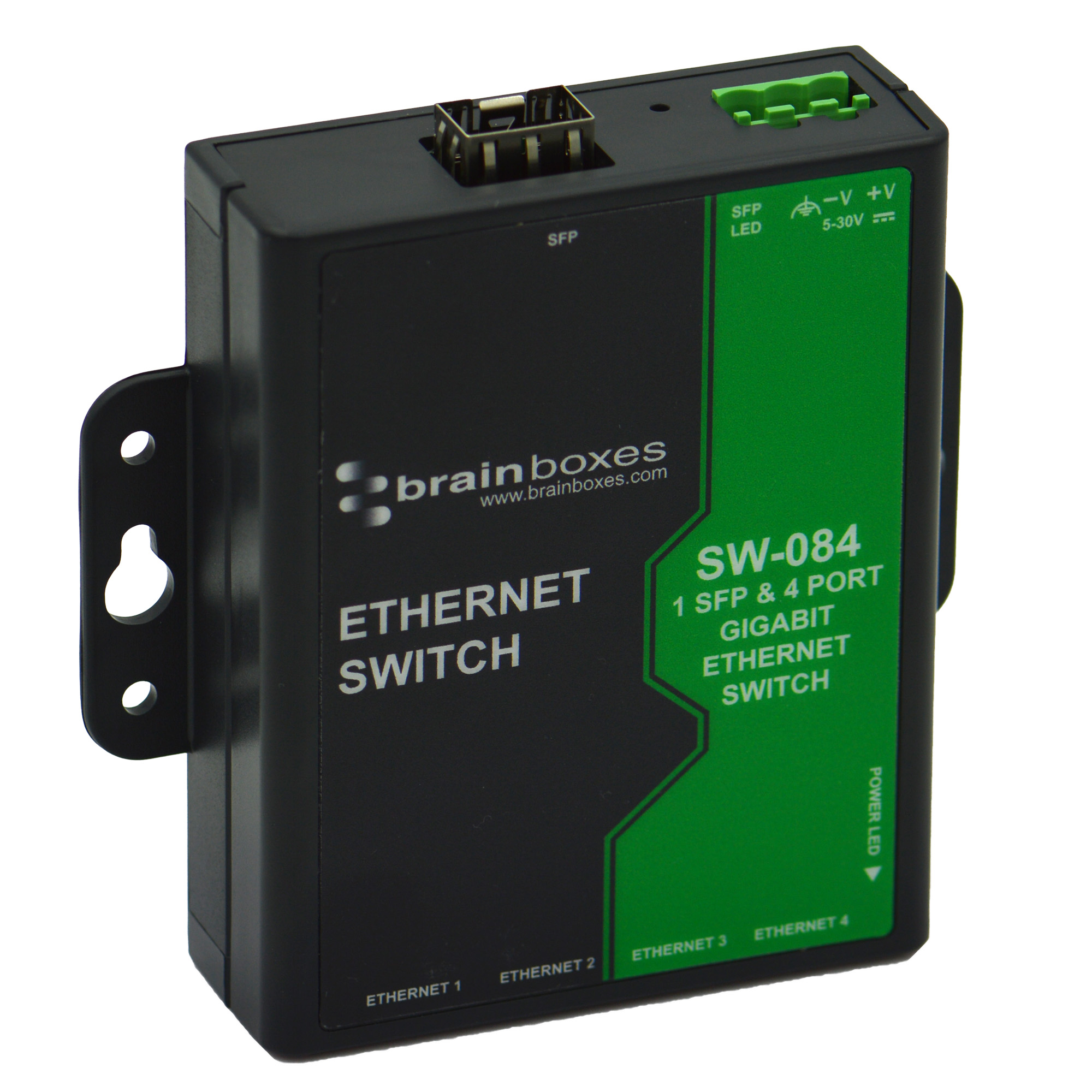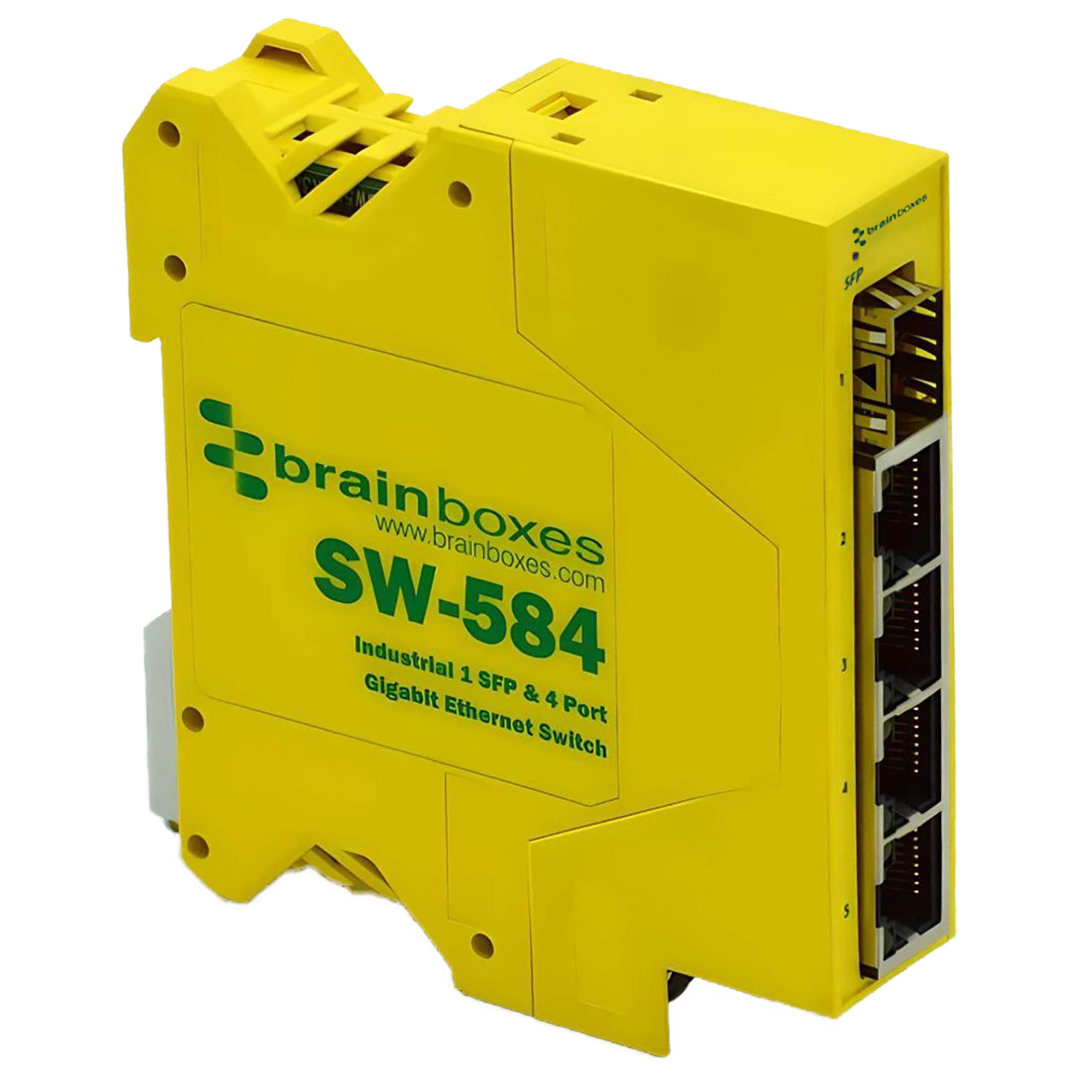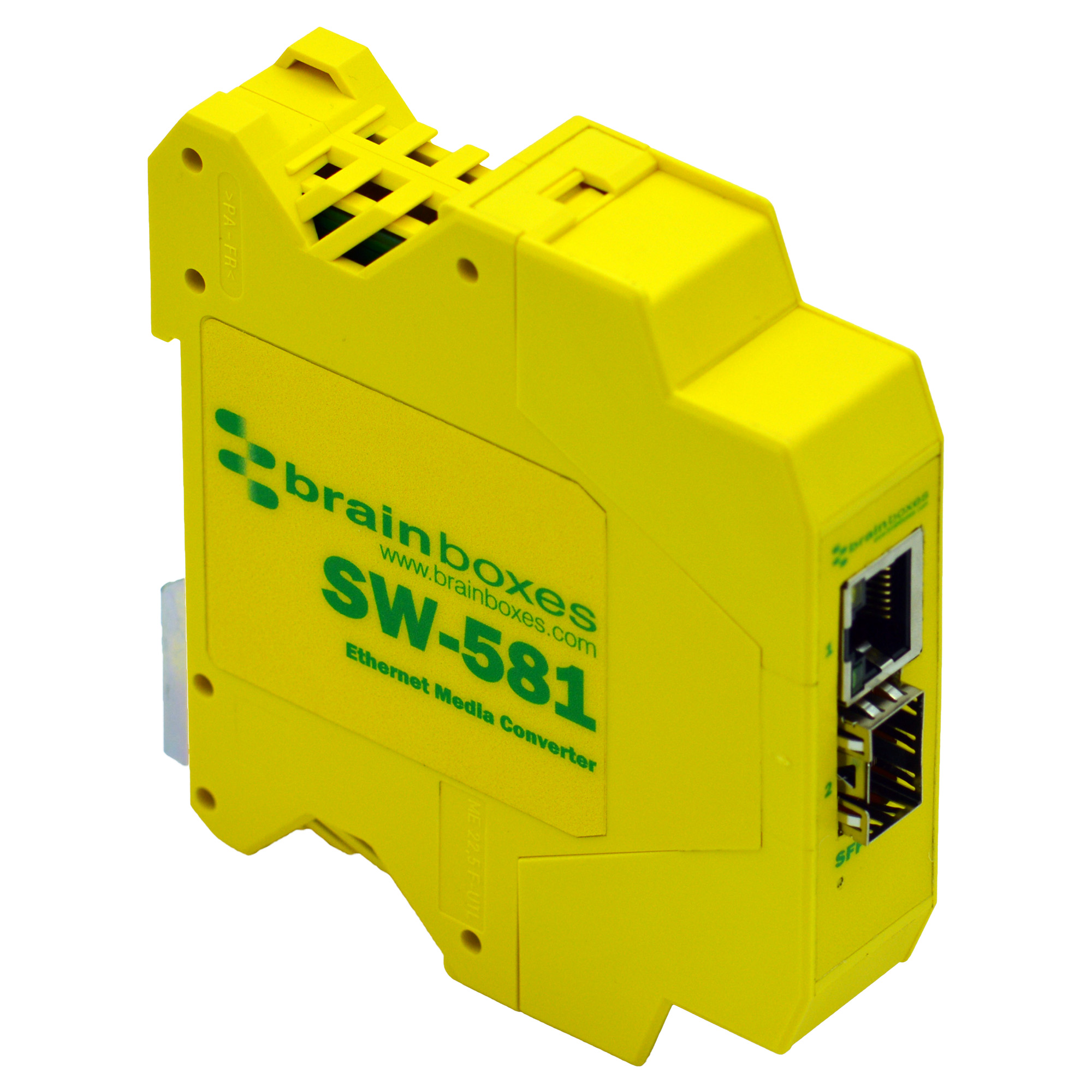FAQs
Contents
- 1. What is Small Form-Factor Pluggable (SFP)?
- 2. Brainboxes SFP Products
- 3. What is the Difference Between SFP & SFP+?
- 4. What Standard is Supported by Brainboxes SFP Products?
- 5. What are the Different SFP Interface Types?
- 6. Single Mode SFP vs Multi-Mode SFP
- 7. What is SFP & SFP+ MSA and Why is it Important?

1. What is Small Form-Factor Pluggable (SFP)?
Small Form-Factor Pluggable, commonly shortened to SFP, is a series of hot-pluggable network interface modules used for data communications. It is a widely used networking solution due to its long transmission distance, high-speed capabilities and ease of use; due to it being hot-pluggable.
2. Brainboxes SFP Products
Brainboxes have released a series of SFP capable products, which you can find on our website here, these include:
- SW-084 – 4x 1Gb RJ45 Ports & 1x 1000BASE-X SFP Port
- SW-584 – Industrial 4x 1Gb RJ45 Ports & 1x 1000BASE-X SFP Port
- SW-581 – Industrial Media Converter – 1x 1Gb RJ45 Port & 1x 1000BASE-X SFP Port
| SW-084 | SW-584 | SW-581 |
|---|---|---|
 |
 |
 |
LED Indicators
The below LED indicators apply to Brainboxes SFP products only:
| Gigabit – RJ45 | SFP | |
|---|---|---|
| Green LED | Yellow LED | Bi-Colour LED |
| Steady = 10/100 Link | Steady = 1Gb Link | Steady Green = Device Powered, No SFP Installed |
| Flashing = Data | Flashing = Data | Steady Orange = SFP Connected, No Link |
| Flashing Orange = SFP Activity | ||
| Flashing Green & Orange = SFP Disabled By Microcontroller |
||
An SFP module may be disabled by the microcontroller for a number of reasons, most commonly due to incompatible hardware or a short circuit. If this occurs and you require assistance, please contact: [email protected]
Brainboxes & Cisco Incompatibility & Manual Workaround
We are currently aware of a native incompatibility issue when attempting to aggregate the SFP link between Brainboxes & Cisco SFP switches. This is as a result of the default auto-negotiation configuration on the Cisco switch preventing the link to the Brainboxes switch being established.
Adding a Manual Workaround:
While the connection between Brainboxes & Cisco SFP switches will fail to aggregate, a manual workaround can be configured (assuming the Cisco switch has a manageable interface). By entering the following commands into the terminal for the Cisco switch, Auto Negotiation can be disabled and force the SFP interface to use a set speed.
In doing so, the SFP link between the Brainboxes & Cisco switches will now come up correctly, allowing data transfer. The commands required for the Cisco switch are as follows:
- interface GigabitEthernetX/X/X
- speed nonegotiate
- spanning-tree portfast disable
Brainboxes has continued development on our SFP range of switch products to ensure compatibility with a range of other switch manufacturers. If having followed the steps above you continue to experience any issues with connecting your Brainboxes SFP switch to another SFP switch, please contact: [email protected]
3. What is the Difference Between SFP & SFP+?
The main difference you will find between SFP & SFP+ is the higher transmission speeds on SFP+. SFP connections typically support data rates up to 1.25Gbps, whereas SFP+ supports higher speeds up to 10Gbps, making it more suited to higher bandwidth applications.
In most cases, SFP+ modules are backwards compatible with SFP ports, but they will be limited to 1.25Gbps. However, SFP modules generally cannot be used in SFP+ ports due to the difference in data rate support.
4. What Standard is Supported by Brainboxes SFP Products?
All Brainboxes SFP products (SW-084, SW-581 & SW-584) only support 1000BASE-X, supporting up to 1Gb transmission speeds. We do not support SFP+.
1000BASE-X is a collective identifier for three types of media segments, two fibre optic & one copper. The two types of fibre optic line are referred to as 1000BASE-SX (Short Wavelength) & 1000BASE-LX (Long Wavelength). The copper line is referred to as 1000BASE-CX, which is a shorter copper jumper, and only has a transmission distance of around 25 meters. 1000BASE-SX has a theoretical maximum transmission distance of 550 meters, while 1000BASE-LX can theoretically cover 10,000 meters (10km).
When to use LX or SX SFP’s and the importance choosing correct SFP’s
When choosing an SFP, it is important to consider the different options available and choose a module that is most suitable to the installation. Generally, it would not be recommended to use a LX SFP transceiver over short distances for a few reasons:
- Overloading the Receiver: LX SFP modules are designed for longer distances and typically use higher power levels for transmitting signals. When used over short distances, the high-power level can overwhelm the receiver in the optical module, leading to errors, degraded performance & potential damage to the SFP receiver.
- Use of Attenuators: To prevent the receiver from being overloaded when using a LX SFP over short distances, optical attenuators are often required. These attenuators reduce the power of the optical signal, but they add complexity and additional cost to the setup.
- Mismatch with Fibre Type: LX SFPs are optimized for Single-Mode Fibre (SMF), which is designed for long-distance communication. For short distances, Multi-Mode Fibre (MMF) with SX SFPs is typically used. Using LX SFPs with MMF can lead to suboptimal performance and potential compatibility issues.
For shorter distances, it would be more optimal to use SX SFP’s which are designed for such installations, providing a more cost effective, simpler and more reliable solution.
5. What are the Different SFP Interface Types?
1000BASE-T (Gigabit Ethernet)
SFP interfaces allow for Ethernet connections using specific modules. These modules connect directly into the SFP port and provide the user with an RJ45 interface with which to connect to their other device. This is supported through the 1000BASE-T standard, representing Gigabit Ethernet over copper cables (shielded twisted pairs).
Direct Attach Copper (DAC)
Direct Attach Copper (DAC) cable, is a twinaxial copper cable that comes with transmission modules from the factory, allowing it to connect directly into SFP ports. Twinax cabling is a cable type, similar to coaxial cabling, but with two inner copper conductor lines as opposed to the singular line found in coaxial cabling.
Fibre
Fibre cables are one of the fastest and most common sources of SFP data transmission, because it transfers data via pulses of light which pass along one or more plastic or glass fibres, transmitting the light to the receiving end where the data is read and converted. Fibre is also not affected by EMI due to the fact it uses light to transmit data, rather than electrical signals.
There are many different options when choosing a fibre cable, below are the specifications of each fibre standard:
| Fibre Cable Type | Jacket Colour | Fibre Core Diameter | Optical Source |
|---|---|---|---|
| OS1 | Yellow | 8 – 10.5µm (Commonly 9µm) |
VCSEL |
| OS2 | Yellow | 8 – 10.5µm (Commonly 9µm) |
VCSEL |
| OM1 | Orange | 62.5µm | LED |
| OM2 | Orange | 50µm | LED |
| OM3 | Aqua | 50µm | VCSEL |
| OM4 | Aqua | 50µm | VCSEL |
| OM5 | Lime Green | 50µm | VCSEL |
| VCSEL – Vertical-Cavity Surface Emitting Laser | |||
| LED – Light Emitting Diode | |||
6. Single Mode SFP vs Multi-Mode SFP
Single Mode SFP works using Single-Mode fibre, which has a typical core diameter of 9µm (micrometres).
It mainly works in 1310nm & 1550nm (nanometres) wavelengths, meaning it is suitable for long-distance data transmission applications, allowing distances up to 80km (providing the transceiver is capable of extended SFP).
Multi-Mode SFP works using multimode fibre, which has a core diameter of 50µm (micrometres).
The most common Multi-Mode SFP transceivers work mainly in 850nm wavelengths, which means it is more suitable for shorter transmission distances, achieving up to 500 meters, once again providing that the transceiver is capable of extended SFP.
Pros & Cons of Single-Mode vs Multi-Mode
As with most cabling, there are positives and negatives associated with their deployment, below is a comparison of Single-Mode vs Multi-Mode fibre:
| Single Mode | Multi-Mode |
|---|---|
| Lower Cabling Cost | Higher Cabling Cost |
| Higher Electronics Cost | Lower Electronics Cost |
| Low Attenuation | High Attenuation |
| Smaller Core, Harder to Terminate | Larger Core, Easier to Terminate |
| Longer Transmission Distances | Shorter Transmission Distances |
| Higher Transmission Speed (100Gb/s) | Lower Transmission Speed (10Gb/s) |
7. What is SFP & SFP+ MSA and Why is it Important?
Multi-Source Agreement (MSA), is a standardization of SFP transceivers and receivers that ensure all ‘MSA Compliant’ SFP modules from vendors, all conform to the same formfactor. It’s an agreement between manufacturers to implement standards for optical modules.
SFP MSA importantly provides consumers with a choice of suppliers for SFP modules, and keeps costs down for customers by providing them the widest array of options.

